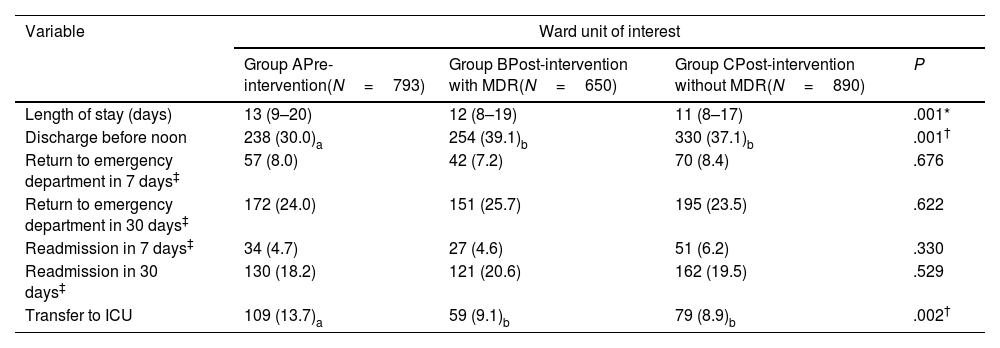Hospitalization significantly interferes with the individual's well-being and it occurs both during and after the hospitalization period. Different approaches to minimize morbidity related to hospitalization and the post-discharge period have been proposed, especially to those aimed at reducing readmission rates. The aim of this study is to evaluate the effect of multicomponent intervention (MI) on operational indicators and continuity of care outcomes.
Materials and methodsA quasi-experimental study conducted in a Brazilian university hospital in order to compare the impact of the intervention with usual care. The MI was the implementation of multidisciplinary rounds, the inclusion of the role of the navigator nurse, and care transition actions with half of the Internal Medicine teams in a clinical unit of a general hospital. Adult patients hospitalized were included in 2 periods and divided in 3 groups – Group A: before the intervention; Group B: after and with MI; Group C after and without MI.
ResultsA total of 2333 hospitalizations were evaluated. There was a reduction in the rate of intensive care transfers to intensive care unit (ICU) and in the length of stay (LOS). LOS, discharge before noon, and transfers to ICU improved when comparing before and after the intervention, but were not different in post-intervention groups with and without MI.
ConclusionThese results reflect the improvement of care provided by MI, an effect that could be due to cross contamination also to teams without the intervention.
La hospitalización interfiere significativamente con el bienestar individual, y ello ocurre tanto durante como después de dicho período de hospitalización. Se han propuesto diferentes enfoques para minimizar la morbilidad relacionada con la hospitalización y el período posterior al alta, especialmente los destinados a reducir las tasas de readmisión. El objetivo es evaluar el efecto de una intervención multicomponente (IM) en los indicadores operativos y los resultados de continuidad de la atención.
Material y métodosSe realizó un estudio cuasiexperimental en un hospital universitario para comparar el impacto de la intervención con la atención habitual. La IM consistió en la implementación de rondas multidisciplinarias, la inclusión del papel de la enfermera gestora de casos y acciones de transición de cuidados con la mitad de los equipos de Medicina Interna en una unidad clínica de un hospital general. Se incluyeron pacientes adultos hospitalizados en dos períodos y se dividieron en tres grupos: grupo A: antes de la intervención; grupo B: después y con IM; grupo C: después y sin IM.
ResultadosSe evaluaron un total de 2.333 hospitalizaciones. Hubo una reducción en la tasa de traslados a la unidad de cuidados intensivos (UCI) y en la duración de la estancia (DE). La DE, el alta antes del mediodía y los traslados a la UCI mejoraron al comparar antes y después de la intervención, pero no fueron diferentes en los grupos postintervención con y sin IM.
ConclusiónEstos resultados reflejan la mejora de la atención proporcionada por IM, un efecto que también podría deberse a la contaminación cruzada con los equipos sin intervención.











